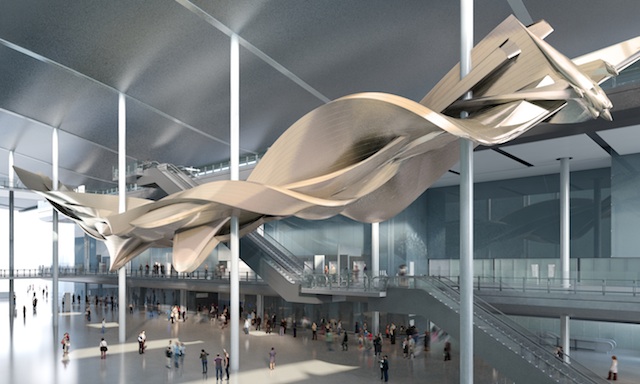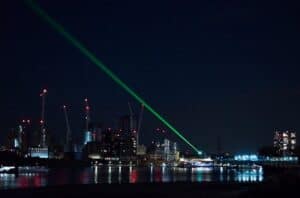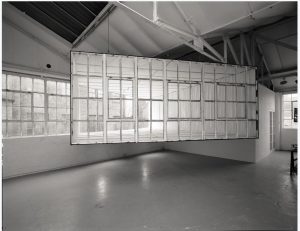
Heathrow Slipstream by Richard Wilson RA © Courtesy of the artist and LHR Airports Limited
On 23 April 2014, six weeks before Heathrow Airport’s new Terminal 2 opens to the public, Slipstream, a major new sculpture, will be unveiled inside the new Terminal building. Created by internationally renowned British artist Richard Wilson RA , Slipstream is an ambitious artwork inspired by the world of aviation and combines precision engineering and specialised UK craftsmanship. The result is a flowing, twisting aluminium form; an imagined flight path of a Zivko Edge 540 stunt plane. Slipstream will be one of the longest permanent sculptures in Europe, measuring over 70 metres long and weighing 77 tonnes.
Slipstream will carve through the length of Terminal 2’s Covered Court and, like so many of Richard Wilson’s large-scale creations, responds to and is integrated within the building’s architecture; supported by four structural columns and suspended between two passenger walkways. The sculpture will be a striking focal point for the airport’s new building, situated by both departures and arrivals to greet passengers. It will be seen by 20 million visitors travelling through the terminal per year.
Richard Wilson, one of Britain’s leading sculptors, is celebrated for his artistic interventions in architectural space and has exhibited extensively, both nationally and internationally. His best known works are the installation ‘20:50’, a sea of reflective sump oil, which is permanently installed in the Saatchi Collection; and his commissioned contribution to Liverpool’s European Capital of Culture 2008, ‘Turning the Place Over’, a vast ovoid section of a disused building façade which rotated to reveal the inside of its structure. He has represented Britain in the Sydney, Sao Paulo, Venice Biennials and Yokohama Triennial and has been nominated for the Turner Prize on two occasions.
Slipstream’s design uses cutting-edge computer programming technology, usually employed by the aerospace industry, to accurately translate the volume of an aircraft’s movement through space. To make Slipstream a reality, Wilson enlisted structural engineers Price & Myers and specialist Hull-based fabricators Commercial Systems International (CSI). The sculpture was manufactured in Hull in 23 giant sections and transported, piece by piece, from Hull to Heathrow in June 2013.
Richard Wilson says
“Slipstream is rooted in its location. This work is a metaphor for travel, it is a time-based work. It is art that moves in time and space coming from the past to the current, delivering different experiences at either end. Sensations of velocity, acceleration and deceleration follow us at every undulation of the form.”
About Heathrow Airport’s new Terminal 2
As part of a £11bn airport development programme, Heathrow are replacing their original Terminal 2 (which stood for more than half a century before closing in 2009). The brand new building will reward flyers with an impressive new space, designed around the individual needs of the 21st century passenger. When it opens 4th June 2014 the new Terminal 2 will serve roughly 20m passengers a year. It will be home to 23 STAR Alliance airlines, Aer Lingus and Germanwings, as well as Virgin Atlantic’s domestic routes.
About Richard Wilson
Richard Wilson is one of Britain’s most renowned sculptors. He is internationally celebrated for his interventions in architectural space, which draw inspiration from the worlds of engineering and construction and are characterized by concerns with size and structural daring.
Wilson has exhibited widely, nationally and internationally, for nearly 40 years and has made major museum exhibitions and public works in countries as diverse as Japan, China, USA, Brazil, Mexico, Russia, Australia, Iraq and numerous countries throughout Europe. Wilson has also represented Britain in the Sydney, Sao Paulo, Venice Biennials and Yokohama Triennial, was nominated for the Turner Prize on two occasions and was awarded the prestigious DAAD residency in Berlin 1992/3. He was one of a select number of artists invited to create a major public work for The Millennium Dome and the only British artist invited to participate in Echigo- Tsumari Art Triennial 2000, Japan.
Wilson’s projects have generated universal critical acclaim. Wilson’s seminal installation ‘20:50’, a sea of reflective sump oil, which is permanently installed in the Saatchi Collection, was described as “one of the masterpieces of the modern age” by the art critic Andrew Graham Dixon in the BBC television series ‘The History of British Art’. Wilson’s commissioned contribution to Liverpool’s European Capital of Culture 2008, titled ‘Turning the Place Over’, comprised a vast ovoid section of a disused building façade that rotated three dimensionally on a spindle. This work won the Ace engineering excellence award 2008. Other works include ‘Square the Block’, 2010 for the LSE Building in London, that both mimics and subverts the existing façade, and ‘18 holes’ for the Folkestone Triennial. Recent work includes the Rooftop Commission at the De La Warr Pavilion, Bexhill as part of the 2012 Cultural Olympiad Festival titled, ‘Hang on a minute lads, I’ve got a great idea’.







